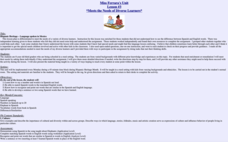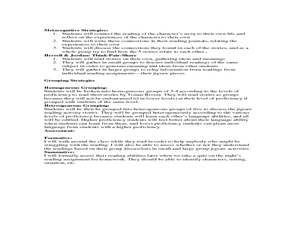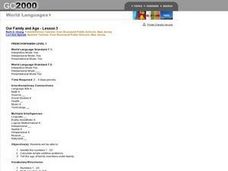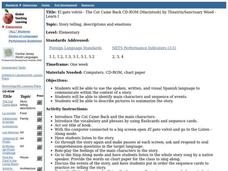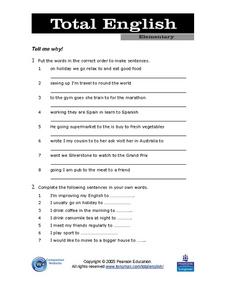Curated OER
Teaching Numbers with Primary Pupils
One, two, three. Un, deux, trois. Eins, zwei, drei. Primary learners love to count and this lesson contains a series of games that encourage learners to count in English, French, German, and Spanish. The exercises develop literacy and...
Smithsonian Institution
Art to Zoo: Life in the Promised Land: African-American Migrants in Northern Cities, 1916-1940
This is a fantastic resource designed for learners to envision what it was like for the three million African-Americans who migrated to urban industrial centers of the northern United States between 1910 and 1940. After reading a...
Curated OER
Counting in Espanol
Pupils create a mini-book with the Spanish numbers 0-10, then compare and contrast the English numbers to the new Spanish numbers.
Curated OER
Using Songs in the Foreign Language Classroom
Students focus on their required lessons in Spanish by integrating music and songs as they complete their assignments. They assess the vocabulary, grammar patterns and culture associated with music and various different songs. Each...
Curated OER
The Impact of Islamic Culture on the Arts of the Renaissance
Eighth graders examine the linguistic and cultural impact of the Arabic language and Islamic culture on the Spanish language. They analyze and label maps, listen to and differentiate between Spanish and Arabic music, and compare and...
Curated OER
Language Spoken in Mexico
Third graders explore how to say numbers and words in Spanish. They match Spanish words to the translated English words. They recognze words that are similar in the Spanish and English language.
Achieve3000
Discriminating Phonemes
Develop the fluency of beginning readers one sound at a time with this phonemic awareness lesson. Through a series of whole-class instruction, independent practice, and collaborative learning activities, children practice identifying the...
Curated OER
Hispanic World - Spain
Take your class on an electronic field trip to Spain! Visit Cordoba or Barcelona, and run with the bulls (virtually) in Pamplona. Groups search the Internet to find sites that permit them to explore the original Spanish-speaking country....
Curated OER
Hispanic and English Literature
Eleventh graders listen to a brief history lesson about the 40's and 50's mid-West America and the Migrant workers that worked the fields. Next, learners will read a short story written by Tomas Rivera (both in Spanish and English)....
Curated OER
Distinguished Discoveries: Florida quarter reverse
Florida's state quarter has an image of a space shuttle and a Spanish Galleon on its reverse side. Pupils will examine the state quarter and think about how the Spanish explorers and Space explorers are the same and different. The class...
Curated OER
Our Family and Age
Start by playing a song about numbers. "Sing, Dance, Laugh, and Eat Quiche" is suggested. Then, start counting things around the room. Introduce yourself, and have kids start to introduce themselves when they catch on to the vocabulary....
Curated OER
Get a Leg Up
Traveling through space is an amazing experience, but it definitely takes a toll on the body. After reading an article and watching a brief video, learners perform an experiment that simulates the effects of zero gravity on the human body.
Curated OER
The Prado Museum
Students visit the Prado Museum website. They explore the website, answer questions in Spanish, interview a classmate, and compare/contrast various artists' works and the Prado museum with a U.S. museum.
Curated OER
Art Exposes
Students view examples of art forms of specific artists. They choose one artist from the country they are studying and present information along with a slide show. Studenys create their own work of art in the style of their chosen...
Curated OER
Counting in Espanol
Students identify the Spanish numbering system from 1-10 and create a mini-book of the numbers. Students compare the English numbers to the Spanish numbers.
Curated OER
Hispanic World - South America Field Trip
Students research a South American Spanish speaking country, analyze and organize the information that they collect and present their findings to the class.
Curated OER
The Cat Came Back
Students are read the story "The Cat Came Back". Using Spanish, they communicate the context of the story with each other. They practice using new vocabulary, identifying main characters and putting the events into order. They use the...
Curated OER
Sentence Order: "Tell Me Why!"
In this sentence order worksheet, students rearrange words to correctly put sentences together. Then they complete sentences in their own words. There are sixteen questions to complete.
Curated OER
Library Curriculum: What Would a Wonderful Library Be Like?
Second graders complete a KWL chart about libraries. They create a book using writing patterns of a particular author. Students decide criteria for awarding the Second Grade Librarian Award to books in the classroom library, and use a...
Curated OER
Traffic signs and signals
Students understand and follow directions based on traffic signs. In this traffic signs lesson plan, students play the game red light green light and are asked why they stop and go according to the colors. They then are introduced to the...
Curated OER
The Roadmap to the Jewish Golden Age of Spain
Students discover, through analysis of media and of primary source historical documents, how Jews achieved high levels of assimilation and acceptance under Islamic rule during the Golden Age of Spain, from the tenth to the twelfth century.
Curated OER
Inca's Untangles World
Students read a reprinted article from USA Today. In this metacognition lesson, students complete a worksheet about their thoughts while they are reading.
Curated OER
Island of the Blue Dolphins Jigsaw
Fourth graders research three topics from the book, either Village Life, Sea Life, or San Nicholas Island. They research independently and meet in a jigsaw format to share what they learned. As group they create a poster for class...
Curated OER
The Present Simple-Daily Routines and Likes and Dislikes
In this daily routines worksheet, students read paragraphs telling about two peoples days, likes, and dislikes. They work in partners to ask and answer twenty-four comprehension questions about each section.







